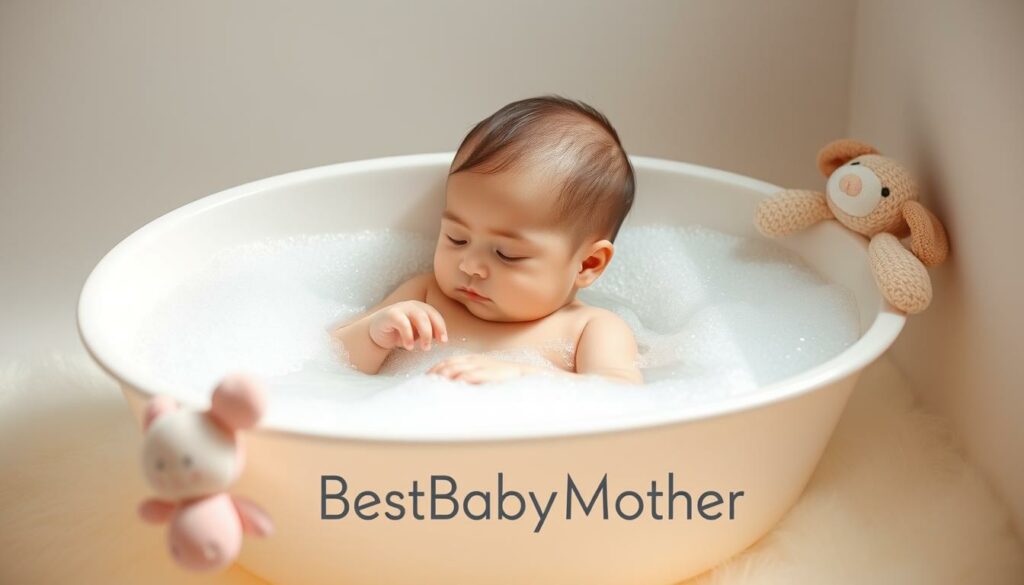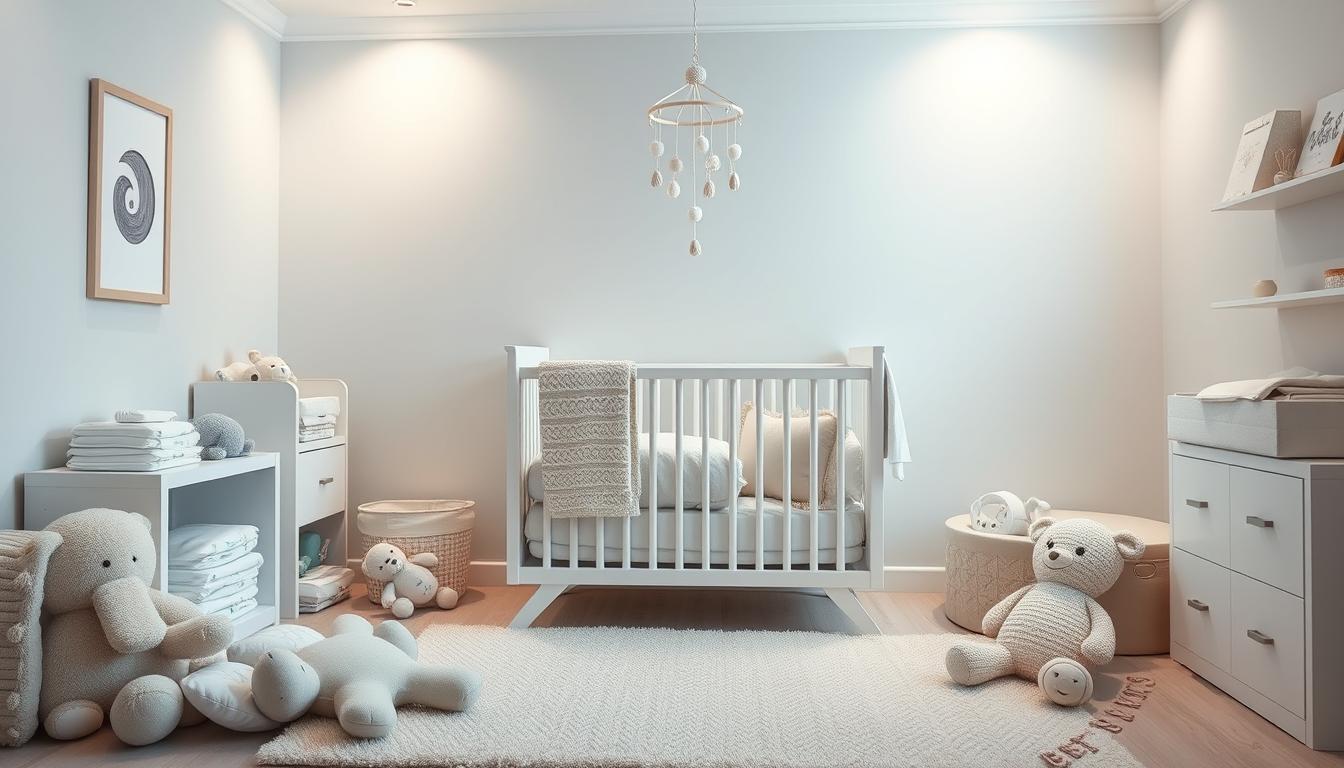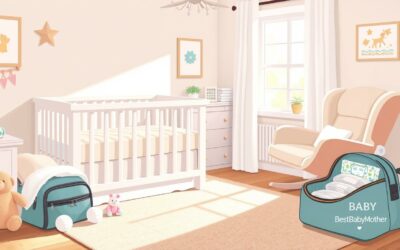Ever felt both excited and scared when starting to care for your newborn? Being a new parent brings lots of feelings and big responsibilities. You’ll learn about the basics of caring for a newborn, setting up feeding times, and keeping your baby healthy. But, what if you had all the important tips right at your fingertips?
Get ready to learn about the most important things every new parent needs to know. This guide will give you the best advice to help you feel confident in this new journey.
Key Takeaways
- Newborns need to be fed every 2–3 hours.
- Babies typically dirty their diapers about 10 times a day.
- Babies usually sleep about 16 hours or more a day.
- Breastfed babies should have about 6 wet diapers and several poops a day.
- The umbilical cord stump typically falls off in 10-21 days.
- Circumcision redness or irritation should heal within a few days to a week.
Getting Help After Bringing Your Baby Home
Welcoming a newborn is a joy, but it comes with challenges. Having the right support makes this time easier and more fun.
Seeking Support from Relatives and Friends
Family support is key when you bring your baby home. Friends and relatives want to help. They can take some stress off your plate.
Heather Mundt from Longmont, Colorado, got help from a neighbor. They paid for a cleaning service. This let Heather focus on herself.
- Fairfield mom Rose Whitney Mishaan loved care packages, especially ones with chocolate babka.
- Atlanta mom Colleen Oakley Tull was helped by a meal train from her best friend.
- Christine Shields Corrigan had her father-in-law visit so she could nap. This helped her recover.
Health Precautions for Visitors
Family support is great, but keeping visitors healthy is also important. Too many visitors can upset your baby. It’s best to:
- Have fewer visitors at once.
- Make sure visitors are healthy and up to date on shots.
- Ask sick visitors to wait until they’re better.
These steps help keep your baby safe from germs.
Self-Care for New Parents
Self-care is crucial for new parents. It’s not selfish; it’s necessary. Olivia Howell from New York had her sister bring coffee and brush her hair. Small acts of kindness can make a big difference.
By taking care of yourself, you can be better for your baby and family.
How to Handle Your Baby Safely
Keeping your baby safe is very important for new parents. Learning how to handle your baby right helps protect their body and immune system. Here are some key tips:
Maintaining Hygiene
Keeping clean is key, especially in the first two months. Babies’ immune systems are weak. Always wash your hands before touching your baby. Make sure everyone who cares for your baby does the same to stop infections.
, hand hygiene is especially important for handling newborns.
Supporting the Baby’s Head and Neck
Supporting your baby’s neck is very important. Newborns have soft spots on their heads and backs. These spots take time to harden. Always support your baby’s head and neck when lifting or holding them to avoid injury.
Importance of Gentle Movements
Being gentle when handling your baby is crucial. Avoid shaking or bouncing them, as it can cause harm. Data shows gentle handling prevents injuries.
Following these tips helps keep your baby safe and happy. For more on caring for newborns and safe handling, check out Best Baby Mother.
Bonding With Your Newborn
Creating a strong bond with your newborn is key for their happiness. This bond helps with their emotional growth, trust, and future friendships. Activities like skin-to-skin contact, emotional bonding, and kangaroo care boost this bond.
Practicing Skin-to-Skin Contact
Skin-to-skin contact, or kangaroo care, is great for bonding. It means holding your baby on your chest for warmth and comfort. Studies show it helps with emotional growth and keeps the baby’s heart and breathing steady.
Regular skin-to-skin contact makes babies feel safe and close. This is important for their development.
Techniques for Emotional Bonding
Emotional bonding happens through daily activities. Actions like holding, stroking, and spending time with your baby are important. Looking into your baby’s eyes, talking, reading, and singing helps their emotional and brain growth.
Fathers and partners are also key in bonding. They play a big role in the baby’s life.
Every baby is unique, and bonding can happen fast for some, slower for others. Health, birth, and mental health can affect bonding time. If bonding is hard, get help from experts.
Soothing Techniques for Your Infant
New parents often struggle to calm their crying babies. This can happen a lot in the second month and last until 4-5 months. It’s important to know how to soothe your baby during this time. Here are some effective ways to help you and your baby relax:
Massage Benefits
 Gentle baby massage is a great way to calm your baby. It helps you bond, relaxes your baby, and supports their development. It’s especially good for premature babies or those with health issues. Regular massage is a chance for you to bond with your baby through touch.
Gentle baby massage is a great way to calm your baby. It helps you bond, relaxes your baby, and supports their development. It’s especially good for premature babies or those with health issues. Regular massage is a chance for you to bond with your baby through touch.
Using Sounds for Comfort
Soft music, white noise, or your singing can soothe a fussy baby. These sounds remind your baby of the womb and make them feel safe. Try adding these comforting sounds to your daily routine to calm your baby.
The Swaddling Method
Swaddling is another method parents use to soothe their babies. It makes your baby feel snug and secure, helping them sleep better. But, it’s important to swaddle safely to avoid any harm. Doing it right can really help your baby relax and sleep better.
In summary, there are many ways to soothe your baby, like baby massage, comforting sounds, and swaddling. Remember, these methods take patience and consistency. Every baby is different, so find what works best for yours.
| Technique | Description | Benefits |
|---|---|---|
| Baby Massage | Gentle, rhythmic stroking of your baby’s body | Promotes relaxation and bonding, aids in development |
| Comforting Sounds | Soft music, white noise, singing | Mimics womb environment, helps baby feel secure |
| Swaddling Technique | Wrapping baby snugly in a blanket | Provides security, limits startle reflex |
Tips for Diapering Your Baby
Diaper changing is key for newborn hygiene. It keeps your baby comfy and rash-free. Being ready and using the right cleaning methods is crucial.
New parents might change diapers up to 10 times a day. That’s almost 3,000 diapers in a year. Keep diapering supplies close to avoid leaving your baby alone.
- Gather Supplies: Have clean diapers, wipes, cream, and a change of clothes ready.
- Clean Gently: Use warm water, cotton balls, or mild infant wipes. Clean from front to back to avoid infections.
- Apply Cream: Use petroleum jelly or zinc oxide-based diaper cream to prevent diaper rash.
- Check for Fit: Make sure the diaper isn’t too tight. Adjust if you see red marks on legs and waist.
Cloth diapers need special care. Prefolded or square diapers might need pinning or folding for small babies. Diaper doublers can help during nighttime.
| Diaper Type | Cleaning Technique | Key Point |
|---|---|---|
| Disposable Diapers | Dispose of wet diapers immediately; empty soiled diapers into the toilet. | Prevent a smelly diaper pail by emptying it daily. |
| Cloth Diapers | Wash separately using a mild detergent suitable for infant clothing. | Prefolded or pinning may be required. |
Good newborn hygiene goes beyond diapers. Wash hands before and after changing diapers to stop germs. Also, talk to your healthcare provider if you worry about diaper rash or umbilical cord issues.
Following these tips keeps your baby clean, comfy, and happy. It also makes you more confident in handling diaper changes.
Proper Techniques for Bathing Your Baby
Bathing a newborn is a delicate process that changes as your baby grows. At first, you’ll use sponge baths. Then, you’ll move to more detailed bathing routines. The goal is to keep your baby clean and comfortable.
Initial Sponge Baths
In the first few weeks, your baby needs sponge baths. This is key for newborn skin care while the umbilical cord stump is still there. The American Academy of Pediatrics suggests sponge baths to prevent infections.
The water should be warm, around 100°F (37.8°C). The room should also be warm. Gently clean their face, hands, and diaper area. Avoid harsh scrubbing or too much moisture.
Apply a small amount of baby oil to the scalp after shampooing. This keeps the skin hydrated.

Transitioning to Tub Baths
When the umbilical cord stump falls off and any circumcision heals, start tub baths. Use shallow water, no more than 2 to 3 inches of warm water. This keeps the experience safe and comfortable.
Follow this process:
- Fill the baby tub with warm water, ensuring the temperature is around 100°F.
- Support your baby’s head and neck with one hand while gently lowering their body into the water.
- Use a gentle, baby-friendly cleanser and avoid excessive bathing, which can dry out their skin.
- Limit the duration of the tub bath to about 5 to 10 minutes.
If your baby seems distressed during tub baths, it’s okay to go back to sponge baths. The key is to keep the bathing experience relaxed and safe. Stick to consistent bathing routines that meet your baby’s needs as they grow.
| Factor | Recommendation |
|---|---|
| Frequency | 3 to 4 times a week |
| Water Temperature | Around 100°F (37.8°C) |
| Umbilical Cord Care | Sponge baths until the stump falls off |
| Water Depth for Tub Baths | 2 to 3 inches |
| Room Temperature | Warm, to prevent chilling |
Umbilical Cord and Circumcision Care
Understanding umbilical cord cleaning and circumcision aftercare is key for newborn care. The umbilical cord stump needs careful cleaning and drying until it falls off. This usually happens in a few weeks.
To clean the umbilical cord, use a damp cloth around the base. Don’t soak the area in water. Use sponge baths until the cord falls off. Watch for signs of infection like redness or a bad smell. If you see these, call your pediatrician right away.
Circumcision care is also very important for healing. Circumcision is common in the U.S. and takes about an hour and a half. A plastic ring used in the Plastibell method falls off in 5 to 10 days. Swelling usually goes away in four days.
Here’s what to do during circumcision aftercare:
- Rinse the area with warm water, not commercial wipes.
- Apply antibiotic ointment or Vaseline with each diaper change until the ring falls off.
- Watch for severe pain, fever over 101°F, and unusual redness or bleeding. Call your pediatrician if you see these signs.
- Use acetaminophen (Tylenol®) for pain, but only as directed.
- Give a daily bath after the umbilical cord falls off until the circumcision heals.
It’s important to know about possible complications and how to handle them. The AAP says tenderness should lessen by day three. Redness and secretions should go away in a week. Full healing takes 7 to 10 days.
For more info and advice on circumcision aftercare, visit this link. Always talk to your healthcare provider for any healing concerns. This ensures your baby follows pediatric care guidelines and heals quickly.
Feeding Your Baby: Breastfeeding and Bottle Options
Knowing how to feed your baby is key for new parents. You can choose breastfeeding or bottle-feeding. It’s important to know your baby’s needs for good nutrition and a healthy start.
Recognizing Feeding Cues
First, learn to spot your baby’s hunger cues. Look for lip-smacking, sucking on hands, and rooting. These signs tell you when it’s time to feed, helping with a smooth infant feeding routine.
- Lip smacking
- Sucking on hands
- Rooting (turning head and opening mouth)
Signs Your Baby Is Getting Enough Milk
It’s crucial that your baby gets enough milk intake. Look for signs like being content after feeding, regular wet diapers, and steady weight gain. For breastfeeding, getting help from lactation consultants can be very helpful.
| Indicator | Description |
|---|---|
| Post-Feeding Contentment | Baby seems satisfied and relaxed after feeding. |
| Regular Wet Diapers | Baby has at least 6-8 wet diapers a day. |
| Consistent Weight Gain | Baby is steadily gaining weight according to pediatric guidelines. |
Burping Techniques
After feeding, it’s important to burp your baby. This helps release air swallowed during feeding. Good ways to burp include holding your baby upright or sitting them on your lap and gently patting their back.
- Hold baby upright against your chest.
- Sit baby on your lap, supporting their head and neck.
- Gently pat or rub baby’s back.
By paying attention to your baby’s feeding cues, making sure they get enough milk intake, and burping them right, you create a caring and healthy feeding space. This supports your baby’s growth and well-being.
Understanding Your Baby’s Sleep Patterns
Knowing about newborn sleep patterns is key for new parents. Babies sleep in shorter cycles than adults, waking up more often. They can sleep 11 to 19 hours a day, waking every 1 to 3 hours for food and more.
Establishing Safe Sleep Practices
Safe sleep practices are crucial for preventing SIDS. The American Academy of Pediatrics suggests babies sleep on their backs. Cribs should be clear of loose items, pillows, and toys.
Infants should sleep on a firm mattress with a fitted sheet. They should only be in parents’ bed for feeding and comfort. These steps have cut SIDS rates by over 50% since 1992.
“The rate of SIDS has dropped more than 50% since the ‘back-to-sleep’ recommendation was made by the American Academy of Pediatrics in 1992.”
Setting a Regular Sleep Routine
A consistent sleep routine helps babies tell day from night. This aids in better sleep habits and sleep training. Newborns sleep about 8 to 9 hours during the day and 8 hours at night.
As they grow, their sleep patterns become more like adults. By six months, babies sleep up to 13 hours a day, with some sleeping longer at night.
Being patient and flexible is important when setting a sleep schedule for your baby. Use routine activities like feeding, bathing, and reading to signal sleep time. Even though babies may wake up often at first, these steps help create better sleep habits over time.
Recognizing and Managing Common Health Issues
Newborns and infants face many infant health concerns. It’s key for parents to spot symptoms that need help. Illnesses like colds, coughs, and fevers are common. But knowing when to get pediatric care is very important.
| Common Health Issue | Symptoms | Management Tips |
|---|---|---|
| Colds and Coughs | Runny nose, sneezing, mild fever | Ensure rest and hydration; avoid giving cough products meant for older children |
| Fever | Body temperature above 100.4°F | Monitor temperature, consult pediatrician if persistent |
| Vomiting | Frequent spitting up, dehydration | Offer fluids, maintain hydration, visit doctor if severe |
| Diaper Rash | Red, irritated skin in diaper area | Keep area dry and clean, use barrier ointments |
| Cradle Cap | Scaly patches on scalp | Gently wash and brush scalp, use mild shampoo |
| Ear Infection | Ear pain, irritability, pulling at ear | Seek pediatric care for appropriate treatment |
| Jaundice | Yellowing of the skin and eyes | Monitor bilirubin levels, ensure proper feeding |
| Colic | Prolonged crying, often in the evening | Use soothing techniques, consult doctor if persistent |
Knowing your baby’s symptoms is key to good health. Watch for signs of discomfort or distress. Use parent resources for help. Quick action can stop problems and keep your baby healthy.
Having good pediatric care and knowing about common illnesses helps you care for your baby. Trust your feelings and always ask a doctor if you’re unsure.
Creating a Safe and Comfortable Nursery
Creating a safe and cozy nursery is key for your baby’s comfort and growth. A well-thought-out nursery setup boosts safety and comfort. It turns your space into a haven for your baby to grow.
Choose the Delta Children Emery 4-in-1 Convertible Crib for around $200. It’s a great pick. Make sure the slats are no more than 2 3/8 inches apart. This meets safety standards to avoid accidents.
Keep the room’s temperature between 68°F and 72°F for comfy sleep. Use organic materials like cotton or linen for bedding and curtains. This supports a healthier and eco-friendly space.
Invest in a Newton Baby Crib Mattress for about $300. It’s a smart choice for your baby’s safety and comfort. Nightlights and natural lighting solutions help manage light and glare, creating a calm atmosphere.
Babyproofing is crucial. Secure all furniture to prevent it from tipping. The Storkcraft Avalon 6 Drawer Universal Dresser for around $300 is a safe and stylish storage option. Night sky and neutral colors are popular for nursery decor, helping your baby relax.
The Infant Optics DXR-8 Video Baby Monitor for about $170 lets you watch your baby anytime. Safety features like the Regalo Easy Step Extra Tall Walk-Thru Gate for about $45 and the Guardian Angel Window Guard at around $100 add safety layers.
The nursery’s layout should make it easy to reach all baby essentials. Arrange furniture like the Delta Children Eclipse Changing Table for $120 and the Munchkin Diaper Duty Organizer for $20. This keeps the nursery organized and efficient. A secure and comfortable nursery supports your baby’s growth and well-being, ensuring peaceful moments for both you and your baby.
FAQ
What are some essential tips for new parents when it comes to infant care?
Focus on feeding, sleeping, and health for your newborn. Learn to recognize feeding cues and establish a sleep routine. Also, ensure frequent health check-ups to stay on top of developmental milestones and health.
How can I effectively seek support from relatives and friends after bringing my baby home?
Don’t hesitate to accept help from family and friends. They can assist with baby care or household chores. Make sure to communicate your needs and set boundaries when necessary.
What health precautions should I take for visitors who want to see the newborn?
Ensure visitors are up to date on vaccinations and are free from illness. Ask them to wash their hands before handling the baby to protect the newborn’s delicate immune system.
Why is self-care important for new parents, and how can they practice it?
Self-care is key for maintaining mental and physical health to care for a newborn. Take breaks, rest when the baby sleeps, and don’t ignore your own nutrition and hydration needs.
What hygiene practices should I follow when handling my baby?
Always wash your hands before touching the baby. Ensure all caregivers do the same to prevent infections and maintain a clean environment around the infant.
How do I properly support my baby’s head and neck?
Always support the baby’s head and neck when lifting or holding them. Use your hand to cradle their head gently.
Why are gentle movements important when handling my baby?
Babies have sensitive and developing bodies. Rough movements or shaking can cause serious harm, so always handle your infant with gentle and deliberate motions.
How can skin-to-skin contact benefit my newborn and me?
Skin-to-skin contact, or kangaroo care, helps regulate the baby’s heartbeat and soothes them. It strengthens bonding. Both mothers and fathers should engage in this practice for the baby’s emotional and physical development.
What are some effective techniques for emotional bonding with my newborn?
Cradling, gentle stroking, and spending quality time interacting with your baby are key techniques. These activities help develop a strong emotional bond and contribute to their overall development.
What are the benefits of massaging my baby?
Infant massage can enhance bonding, aid in development, and soothe various medical conditions, especially in preterm babies. It’s a beneficial practice for both parent and infant.
How can sounds be used to comfort a fussy baby?
Soft singing, playing gentle music, or white noise can help calm a distressed baby. These sounds provide comfort and can soothe them to sleep.
How do I safely swaddle my baby?
Swaddle your baby so that their hips can move and ensure that the fabric is not too tight around the chest. Proper swaddling can help them feel secure and may reduce the startle reflex.
What are the key steps to follow when diapering my baby?
Change diapers frequently, clean the area from front to back using wipes or water and cotton balls. Apply diaper cream to prevent rash, and practice good hand hygiene post-diapering to maintain cleanliness.
How should I give my newborn their initial sponge baths?
Use a soft cloth to gently clean the baby’s body, keeping them warm. Sponge baths should continue until the umbilical cord stump falls off and any circumcision has healed.
How can I transition my baby from sponge baths to tub baths?
Start with brief and gentle tub baths. If your baby finds tub baths distressing, it’s okay to revert to sponge baths temporarily. Consistent and gentle bathing helps maintain hygiene.
What care is needed for an infant’s umbilical cord and circumcision?
Keep the umbilical cord stump clean and dry until it falls off naturally. For circumcision care, clean the area with warm water, apply petroleum jelly, and change the gauze with each diaper change to avoid infection.
How can I recognize feeding cues from my infant?
Look for signs such as rooting, sucking on hands, or making sucking noises. Recognizing these cues helps you respond promptly to your baby’s hunger needs.
What are the signs that my baby is getting enough milk?
Signs include contentment post-feeding, regular wet diapers, and consistent weight gain. These indicators show that your baby is receiving adequate nutrition.
What techniques can I use to burp my baby effectively?
Hold your baby upright against your chest or seated on your lap and gently pat or rub their back. Burping helps release the swallowed air that can cause discomfort.
What are some safe sleep practices for my baby?
Place your baby on their back to sleep, use a firm mattress, and keep the crib free of loose bedding to lower the risk of SIDS. A consistent sleep environment aids safe sleep.
How can I set a regular sleep routine for my newborn?
Establish a consistent bedtime routine, differentiate day and night activities, and be patient as the baby learns to adapt. Consistent routines promote long-term healthy sleep habits.
How should I recognize and manage common health issues in my infant?
Stay informed on potential symptoms and milestones. Consult a pediatrician when concerns arise, and provide a safe, clean environment to help reduce the likelihood of illness.
What steps should I take to create a safe and comfortable nursery?
Babyproof the space, choose a safe crib, and select decor that creates a calm atmosphere. Ensure easy access to essentials and regulate temperature and lighting for an ideal environment for your baby.













